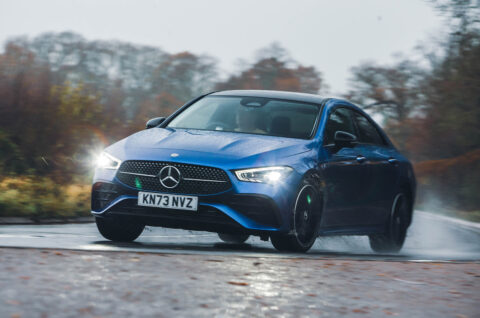
Mercedes’ 2.0-litre petrol engines may be gone from the CLA, but they are no great loss to it. When we tested the pre-facelift CLA 250 in 2019, we found it noisy and a little unsatisfying to drive. Both the updated CLA 250e, meanwhile, and the CLA 220d are now fairly rounded, with good cruising manners, decent performance, reasonable drivability and quite impressive efficiency.
The plug-in hybrid is a car you can expect around 35 miles of electric range from in mixed daily use, or about 25% less at exclusively out-of-town speeds. Electric-only performance is sufficient for urban driving, and whisks you up to about 50mph with enough authority to keep pace with the traffic. You do become aware that the motor’s driving through a dual-clutch automatic gearbox, though, when it takes a second or two to respond to initial accelerator pedal inputs, and when it shifts gears on the run. Even in electric mode, the CLA 250e doesn’t quite feel like driving an EV.
When the car blends in combustion engine power, it can be a little coarse; the 1.3-litre piston engine is a bit noisy when cold and when revving hard; and you can tell it’s part of quite a tight under-bonnet package of components because overall mechanical refinement is only average for the class. But, when it’s warm and just doing the necessary for everyday cruising, it settles to a quiet background noise level.
If you use lots of power, the CLA 250e’s driven front axle can struggle for traction, especially when conditions are slippery. The car’s electronics quell the consequences, though not especially neatly or quickly. Likewise, if you want to shift gears for the car yourself in manual mode during keener driving, you’ll find the gearbox a little slow to act, though it does a reasonable job. So, in slippery conditions, our CLA 250e test car needed a little over eight seconds to hit 60mph from rest, where Mercedes advertises it in less than 7.5sec.
The CLA’s 2.0-litre diesel engine actually makes for slightly quicker claimed acceleration and, on the road, the CLA 220d does feel assured in its performance level, and a little simpler to drive. It has plenty of accessible torque, the piston engine’s slightly sluggish engine start-stop system being the only barrier to responsiveness in a generally impressive, and creditably refined, diesel driving experience.
Assisted driving – 4 stars
The CLA offers more semi-autonomous driving tech than most cars of its size, type and price, and more effective assisted driving tech.
Spend £1495 on the Driving Assistance pack (only offered on range-topping AMG Line Premium Plus cars) and you’ll get a car that can change lanes by itself on the motorway, but only when it’s safe to do so; can intervene with braking to prevent you wandering into the path of a car coming either head-on or at a T-junction; and can adopt temporary gantry speed limits by itself.
The speed limit detection system doesn’t quite catch every posted limit, and usually waits until passing a sign before starting to adjust speed, but it can be relied on by and large.
Some will find the car’s default reactivation of its lane keeping and autonomous braking systems with every restart annoying – but this is an EU legal homologation requirement. When left on, the lane keeping system only ‘wakes up’ when you pass 40mph out of town, and while it can be mildly irksome on winding roads, it isn’t so bothersome most of the time.
Generally, the CLA’s assisted driving systems work well when they’re on, are cleverly and progressively tuned, and are easy enough to switch off if you so choose. And there is no annoying driver monitoring system here to contend with – yet.
